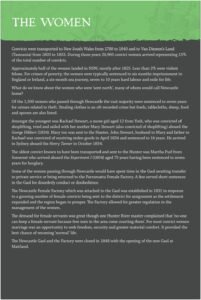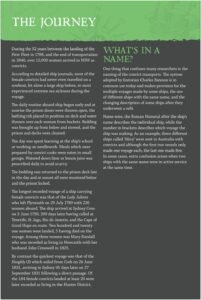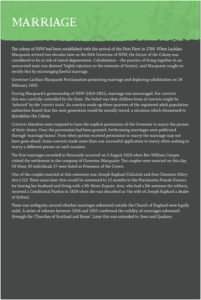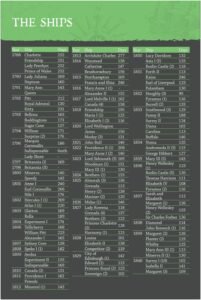 Convicts were transported to New South Wales from 1788 to 1840 and to Van Diemen’s Land (Tasmania) from 1803 to 1853. During those years 24,960 convict women arrived representing 15% of the total number of convicts.
Convicts were transported to New South Wales from 1788 to 1840 and to Van Diemen’s Land (Tasmania) from 1803 to 1853. During those years 24,960 convict women arrived representing 15% of the total number of convicts.
Approximately half of the women landed in NSW, mostly after 1825. Less than 2% were violent felons. For crimes of poverty, the women were typically sentenced to six months imprisonment in England or Ireland, a six-month sea journey, seven to 10 years hard labour and exile for life.
What do we know about the women who were ‘sent north’, many of whom would call Newcastle home?
Of the 1,800 women who passed through Newcastle the vast majority were sentenced to seven years for crimes related to theft. Stealing clothes is an oft recorded crime but fowls, tablecloths, sheep, food and spoons are also listed.
Amongst the youngest was Rachael Stewart, a nurse girl aged 12 from York, who was convicted of shoplifting, tried and sailed with her mother Mary Stewart (also convicted of shoplifting) aboard the George Hibbert (1834). Mary too was sent to the Hunter. John Stewart, husband to Mary and father to Rachael was convicted of receiving stolen goods in April 1834 and sentenced to 14 years. He arrived in Sydney aboard the Henry Tanner in October 1834.
The oldest convict known to have been transported and sent to the Hunter was Martha Purl from Somerset who arrived aboard the Experiment I (1804) aged 75 years having been sentenced to seven years for burglary.
Some of the women passing through Newcastle would have spent time in the Gaol awaiting transfer to private service or being returned to the Parramatta Female Factory. A few served short sentences in the Gaol for disorderly conduct or disobedience.
The Newcastle Female Factory which was attached to the Gaol was established in 1828 in response to a growing number of female convicts being sent to the district for assignment as the settlement expanded and the region began to prosper. The Factory allowed for greater regulation in the management of the women.
The demand for female servants was great though one Hunter River master complained that ‘no-one can keep a female servant because free men in the area come courting them’. For most convict women marriage was an opportunity to seek freedom, security and greater material comfort. It provided the best chance of resuming ‘normal’ life.
The Newcastle Gaol and the Factory were closed in 1848 with the opening of the new Gaol at Maitland8
 During the 52 years between the landing of the First Fleet in 1788, and the end of transportation in 1840, over 12,000 women arrived in NSW as convicts.
During the 52 years between the landing of the First Fleet in 1788, and the end of transportation in 1840, over 12,000 women arrived in NSW as convicts.
According to detailed ship journals, most of the female convicts had never even travelled on a rowboat, let alone a large ship before, so most experienced extreme sea sickness during the voyage.
The daily routine aboard ship began early and at sunrise the prison doors were thrown open, the bathing tub placed in position on deck and water thrown over each woman from buckets. Bedding was brought up from below and stowed, and the prison and decks were cleaned.
The day was spent learning at the ship’s school or working on needlework. Meals which were prepared by convict cooks were eaten in small groups. Watered down lime or lemon juice was prescribed daily to avoid scurvy.
The bedding was returned to the prison deck late in the day and at sunset all were mustered below and the prison locked.
The longest recorded voyage of a ship carrying female convicts was that of the Lady Juliana who left Plymouth on 29 July 1789 with 226 women aboard. The ship arrived at Sydney Cove on 3 June 1790, 309 days later having called at Tenerife, St Jago, Rio de Janerio, and the Cape of Good Hope en route. Two hundred and twenty one women were landed, 5 having died on the voyage. Among these women was Mary Randall who was recorded as living in Newcastle with her husband John Cresswell in 1825.
By contrast the quickest voyage was that of the Hooghly (3) which sailed from Cork on 24 June 1831, arriving in Sydney 95 days later on 27 September 1831 following a direct passage. Of the 184 female convicts landed at least 20 were later recorded as living in the Hunter District.
WHAT’S IN A NAME?
One thing that confuses many researchers is the naming of the convict transports. The system adopted by historian Charles Bateson is in common use today and makes provision for the multiple voyages made by some ships, the use of different ships with the same name, and the changing description of some ships after they underwent a refit.
Name-wise, the Roman Numeral after the ship’s name describes the individual ship, while the number in brackets describes which voyage the ship was making. As an example, three different ships called ‘Mary’ were sent to Australia with convicts and although the first two vessels only made one voyage each, the last one made five. In some cases, extra confusion arises when two ships with the same name were in active service at the same time.
 The Industrial Revolution in Britain bought about huge change pushing the rural population towards the cities which then became overcrowded. Jobs were scarce, and people struggled to survive. Petty crime became rampant. Swift apprehension was almost inevitable, and penalties severe.
The Industrial Revolution in Britain bought about huge change pushing the rural population towards the cities which then became overcrowded. Jobs were scarce, and people struggled to survive. Petty crime became rampant. Swift apprehension was almost inevitable, and penalties severe.
Due to the American Revolution the transportation of British convicts to America was no longer an option and in order to relieve the stress on Britain’s Gaols transportation to NSW commenced. The First Fleet set sail on 13 May 1787 with 11 ships eventually settling in Sydney Cove.
It was not long before it became apparent that convicts who were difficult to manage or offended for a second time would need to be isolated from the rest. Newcastle, or Coal River as it was then known, provided a suitably remote location while also providing an abundance of essential items such as coal, cedar, salt and lime.
Between 1804 and 1824, when Newcastle officially ceased to be a place of secondary transportation, an increasing number of female convicts made their way into the Port of Newcastle from Sydney by sea. The vessels most frequently associated with transporting female convicts from Sydney to Newcastle were the Elizabeth Henrietta, the Estramina, and the Lady Nelson.
The women were to be provided with: one jacket, one petticoat, one shift, one cap, one handkerchief, one pair of stockings, and one pair of shoes. A lack of supplies and abuse of the system often led to difficulties supplying these requirements.
From the end of 1823 the numbers of convicts, both male and female, began to drop as Newcastle ceased to be the location of secondary transportation in NSW. Port Macquarie took on the role and many of Newcastle’s convicts and soldiers shifted further north.
Of course, not all the convicts ventured north. Many had been assigned to settlers in the Newcastle and Hunter Region and consequently remained in the area. Many of the female convicts had also married and they, too, remained in the area.
Neither did Newcastle cease to function completely as a destination for female convicts after 1823. One such instance was following the Parramatta Female Factory Riot of February 1831 when most of the women involved were sent to Newcastle on 5 March 1831.
Another instance was in October of 1832 when some 40 women were selected from the Parramatta Female Factory, under the instructions of the Colonial Secretary, and sent to Newcastle by boat. The purpose of this exercise was to allow the unwed men of the district the opportunity of selecting a wife. Mary Ahearn, the last female convict on this list, was selected by Joseph Jones (Hadlow, 1818). Their banns were posted, and they wed on 12 January 1833, after which Mary was assigned to her husband, which was not uncommon. The couple settled down to raise a family on a farm near Tarro until they were forced to leave the area due to droughts and depression during the period between 1843 and
1851.
There were also transport ships carrying female convicts which had their charges directed straight to Newcastle after their arrival at Port Jackson. On board the Pyramus (2) which arrived in late December 1836 were 31 such women who came straight to Newcastle for assignment. Judith Cuffe, from Dublin, found herself working in the hospital attached to Newcastle Gaol shortly after her arrival.
Some of the 1,800 female convicts identified merely passed through but others remained to become the pioneers and matriarchs of the region, their large families populating the Hunter where many descendants remain to this day.
 The colony of NSW had been established with the arrival of the First Fleet in 1788. When Lachlan Macquarie arrived two decades later as the fifth Governor of NSW, the future of the Colony was considered to be at risk of moral degeneration. Cohabitation – the practice of living together in an unmarried state was deemed ‘highly injurious to the interests of Society’, and Macquarie sought to rectify this by encouraging lawful marriage.
The colony of NSW had been established with the arrival of the First Fleet in 1788. When Lachlan Macquarie arrived two decades later as the fifth Governor of NSW, the future of the Colony was considered to be at risk of moral degeneration. Cohabitation – the practice of living together in an unmarried state was deemed ‘highly injurious to the interests of Society’, and Macquarie sought to rectify this by encouraging lawful marriage.
Governor Lachlan Macquarie Proclamation promoting marriage and deploring cohabitation on 24 February 1810.
During Macquarie’s governorship of NSW (1810-1821), marriage was encouraged. For convicts this was carefully controlled by the State. The belief was that children born of convicts might be ‘infected’ by the ‘convict stain’. As convicts made up three-quarters of the registered adult population authorities feared that the next generation would be morally tarred, a situation which threatened to destabilise the Colony.
Convicts therefore were required to have the explicit permission of the Governor to marry the person of their choice. Once the permission had been granted, forthcoming marriages were publicised through ‘marriage banns’. Even when parties received permission to marry the marriage may not have gone ahead. Some convicts made more than one successful application to marry often seeking to marry a different person on each occasion.
The first marriages recorded in Newcastle occurred on 3 August 1818 when Rev William Cowper visited the settlement in the company of Governor Macquarie. Ten couples were married on this day. Of these 20 individuals 17 were listed as Prisoners of the Crown.
One of the couples married at this ceremony was Joseph Raphael (Calcutta) and Ann Clements (Mary Ann I (1)). Three years later Ann would be sentenced to 12 months in the Parramatta Female Factory for leaving her husband and living with a Mr Howe Esquire. Ann, who had a life sentence for robbery, received a Conditional Pardon in 1828 when she was described as ‘the wife of Joseph Raphael a dealer of Sydney’
There was ambiguity around whether marriages solomised outside the Church of England were legally valid. A series of reforms between 1834 and 1855 confirmed the validity of marriages solomised through the ‘Churches of Scotland and Rome’. Later this was extended to Jews and Quakers.
|
|
|
